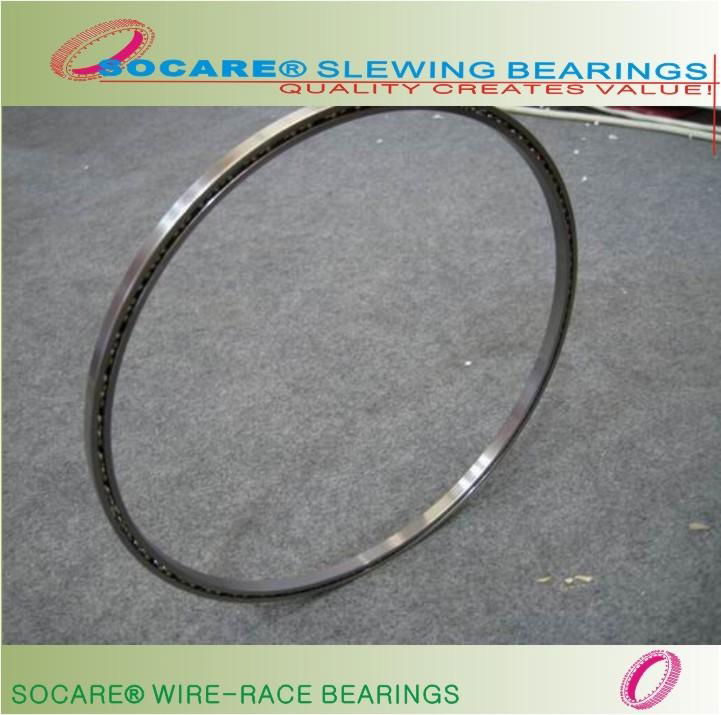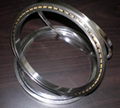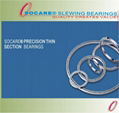| Model: | JU090XPO |
|---|---|
| Brand: | SOCARE |
| Origin: | Made In China |
| Category: | Transportation / Car Parts & Components |
| Label: | Thin Section Ball Be , Thin Section Be , SLIM BEARING |
| Price: |
US $220
/ pc
|
| Min. Order: | 10 pc |
Product Description
What is a Thin Section Bearing and Ho w does it Reduce Cost?
THIN SECTION bearings are a family of bearings designed from a limited number of widths and thicknesses (cross sections), with each cross section manufactured in a wide range of bore diameters. Most radial ball bearings are designed so that as the bore size increases, the width and the thicknessMofMthe bearing change proportionately. In the case of thin section bearings the cross section remains the same as the bore diameter increases. The thin section bearing family is made up of 9 primary cross section sets ranging from 3/16" to 1"and with bore sizes ranging from 1" to over 40". The combination of a large bore diameter in proportion to the small cross section makes these parts appear "Thin" in comparison to standard ball bearings. Thin section bearings are made from 52100 chrome steel and 440C stainless steel. They can also be coated with platings like thin dense chrome. Some sizes can be configured with seals or shields. Thin section bearings are also made in one of three different contact styles; radial contact, angular contact, and four point contact. These options, along with several ball and retainer types make for a diverse range of parts even among the limited cross sections of the thin section bearing family.
Thin section bearings help reduce total cost in a system by allowing for design efficiency over standard bearing sizes. Because thin section bearings have cross sections that don°Øt change as bore sizes increase, there needs to be no change in the space requirements, and little change in the weight of the bearing, even as the diameter of an application increases. Especially in the case of medical equipment, airborne optical and infrared scanning equipment, and robotics, the space and weight requirements of a system are major factors in the overall design and manufacturing cost. In many cases, the price of a thin section bearing is higher than a standard bearing with a similar bore size, but application and design savings due to reduced space and lower weight decrease the total cost in the application.
Thin Section Ball Bearing Applications
© Medical Equipment
© Rotary polishing equipment
© X-ray MRI
© Rotary pipe cutting equipment
© Rotary welding equipment
© Semi-conductor equipmentRotary actuators
© Rotary work holding tables
© Aerospace auxiliary equipment
© (not flight critical) Turrets
© Gun turrets
© Turntables
© Gun Barrel Mounts
© Indexing tables
© Missile launchers
© Machine tools + Lathe accessories
© Radar equipment
© Robotics
© Radar drives
© Antenna pedestals
© Packaging equipment
© Satellite antennas + PedestalsLabeling machines
© Truck mounted communication equipment
© Food processing equipment
© Bottling equipment
© Optical equipment
©Converting equipment
© Telescope bases
© Wallpaper + Screen printing
© Camera mounts
© Textile + Knitting machinery
© Optical drivers
© Tire production equipment
© Security camera mountsWire handling, winding,Bonding equipment
© Oil well equipment
© Mounts for Sensors + Equipment
© Blow out protectors
© Instrument mounts
© King post bearing applications
© Gimbals + Gimbal assemblies
© Gear boxes
© Slip rings
© Transmission gear and chain
© Rotary unions + Rotary jointsClutch backstops
Installation
If thin section bearings are being installed into a housing, pressure should be applied only on the outer ring. Bearings to be installed on a shaft should be pushed on the inner
ring. Since the majority of SOCARE® bearings are open (without seals),a clean, contaminant-free installationarea is advised.
Lubrication
Rolling element anti-friction bearings rely on ball and raceway surface lubrication. A thin film of oil or grease should be used. Be sure not to contaminate the lubricant used in the bearings. Our standard open (unsealed) bearings are shipped with only a light oil as a corrosion inhibitor. You must lubricate these bearings with the appropriate grease
or oil for your application. Sealed bearings are shipped as standard practice with 20% - 30% fill of Mil-G-81322 grease.
Load Ratings
Information listed in this catalog such as load ratings and bearing dimensional data has been compiled from industry standard data as well as ABMA and ANSI information and formulas. Technical information and ratings have been modified from empirical data and test data from
SOCARE® Load capacities show in the catalog are not additive. For combined radial and axial loading an equivalent radial loading must be calculated.
Housing & Shaft Fits
Thin section bearings are affected by the tolerance, roundness, and expansion & contraction rates of the housing & shafts used to mount these bearings. The "Precision toler- ances & Recommended Fits" shown in this catalog are for bearings with standard diametral clearance and steel shafts & housings. Bearings with special clearances or preloads and those which are mounted in, or have shafts in, materials other than steel, will need special internal clear-ance consideration to account for different expansion & contraction rates of dissimilar materials.
THIN SECTION bearings are a family of bearings designed from a limited number of widths and thicknesses (cross sections), with each cross section manufactured in a wide range of bore diameters. Most radial ball bearings are designed so that as the bore size increases, the width and the thicknessMofMthe bearing change proportionately. In the case of thin section bearings the cross section remains the same as the bore diameter increases. The thin section bearing family is made up of 9 primary cross section sets ranging from 3/16" to 1"and with bore sizes ranging from 1" to over 40". The combination of a large bore diameter in proportion to the small cross section makes these parts appear "Thin" in comparison to standard ball bearings. Thin section bearings are made from 52100 chrome steel and 440C stainless steel. They can also be coated with platings like thin dense chrome. Some sizes can be configured with seals or shields. Thin section bearings are also made in one of three different contact styles; radial contact, angular contact, and four point contact. These options, along with several ball and retainer types make for a diverse range of parts even among the limited cross sections of the thin section bearing family.
Thin section bearings help reduce total cost in a system by allowing for design efficiency over standard bearing sizes. Because thin section bearings have cross sections that don°Øt change as bore sizes increase, there needs to be no change in the space requirements, and little change in the weight of the bearing, even as the diameter of an application increases. Especially in the case of medical equipment, airborne optical and infrared scanning equipment, and robotics, the space and weight requirements of a system are major factors in the overall design and manufacturing cost. In many cases, the price of a thin section bearing is higher than a standard bearing with a similar bore size, but application and design savings due to reduced space and lower weight decrease the total cost in the application.
Thin Section Ball Bearing Applications
© Medical Equipment
© Rotary polishing equipment
© X-ray MRI
© Rotary pipe cutting equipment
© Rotary welding equipment
© Semi-conductor equipmentRotary actuators
© Rotary work holding tables
© Aerospace auxiliary equipment
© (not flight critical) Turrets
© Gun turrets
© Turntables
© Gun Barrel Mounts
© Indexing tables
© Missile launchers
© Machine tools + Lathe accessories
© Radar equipment
© Robotics
© Radar drives
© Antenna pedestals
© Packaging equipment
© Satellite antennas + PedestalsLabeling machines
© Truck mounted communication equipment
© Food processing equipment
© Bottling equipment
© Optical equipment
©Converting equipment
© Telescope bases
© Wallpaper + Screen printing
© Camera mounts
© Textile + Knitting machinery
© Optical drivers
© Tire production equipment
© Security camera mountsWire handling, winding,Bonding equipment
© Oil well equipment
© Mounts for Sensors + Equipment
© Blow out protectors
© Instrument mounts
© King post bearing applications
© Gimbals + Gimbal assemblies
© Gear boxes
© Slip rings
© Transmission gear and chain
© Rotary unions + Rotary jointsClutch backstops
Precision Thin Section Bearings Are Special
The SOCARE® Series are manufactured to industry standard sizes.The bearing widths and sections
(distance from bore to outside diameter) in each series remains constant regardless of the change
in bore diameter.
Inspection
Due to the large diameters and thin sections of these bearing products,it is necessary to address
measurement and inspection techniques. To accurately measure the bore and outside diameters of
thin section bearings, a specific procedure must be followed.
Appropriate measuring equipment must be used which will allow the inspector to take 3 to 5 readings
around the circumference which are then averaged to determine the true measurement of the bearing in the free state (unmounted). This procedure allows for the inherent out-of-roundness these bearings
will exhibit. When measuring these bearings, special care must be exercised to ensure neither the bearing weight or pressure from the measuring ,equipment affects the measurements.
The SOCARE® Series are manufactured to industry standard sizes.The bearing widths and sections
(distance from bore to outside diameter) in each series remains constant regardless of the change
in bore diameter.
Inspection
Due to the large diameters and thin sections of these bearing products,it is necessary to address
measurement and inspection techniques. To accurately measure the bore and outside diameters of
thin section bearings, a specific procedure must be followed.
Appropriate measuring equipment must be used which will allow the inspector to take 3 to 5 readings
around the circumference which are then averaged to determine the true measurement of the bearing in the free state (unmounted). This procedure allows for the inherent out-of-roundness these bearings
will exhibit. When measuring these bearings, special care must be exercised to ensure neither the bearing weight or pressure from the measuring ,equipment affects the measurements.
Installation
If thin section bearings are being installed into a housing, pressure should be applied only on the outer ring. Bearings to be installed on a shaft should be pushed on the inner
ring. Since the majority of SOCARE® bearings are open (without seals),a clean, contaminant-free installationarea is advised.
Lubrication
Rolling element anti-friction bearings rely on ball and raceway surface lubrication. A thin film of oil or grease should be used. Be sure not to contaminate the lubricant used in the bearings. Our standard open (unsealed) bearings are shipped with only a light oil as a corrosion inhibitor. You must lubricate these bearings with the appropriate grease
or oil for your application. Sealed bearings are shipped as standard practice with 20% - 30% fill of Mil-G-81322 grease.
Load Ratings
Information listed in this catalog such as load ratings and bearing dimensional data has been compiled from industry standard data as well as ABMA and ANSI information and formulas. Technical information and ratings have been modified from empirical data and test data from
SOCARE® Load capacities show in the catalog are not additive. For combined radial and axial loading an equivalent radial loading must be calculated.
Housing & Shaft Fits
Thin section bearings are affected by the tolerance, roundness, and expansion & contraction rates of the housing & shafts used to mount these bearings. The "Precision toler- ances & Recommended Fits" shown in this catalog are for bearings with standard diametral clearance and steel shafts & housings. Bearings with special clearances or preloads and those which are mounted in, or have shafts in, materials other than steel, will need special internal clear-ance consideration to account for different expansion & contraction rates of dissimilar materials.
| Price Terms: | FOB |
|---|---|
| Payment Terms: | tt |
| Packing: | SUIT FOR LONG-TERM MARIONE TRANSIT |
| Lead Time: | WITHIN 25 WORKING DAYS |
Member Information
| SOCARE INTERNATIONAL (QINGDAO)CO.,LTD | |
|---|---|
| Country/Region: | Shan Dong - China |
| Business Nature: | Manufacturer |
| Phone: | 18653028886 |
| Contact: | Mr.BingTin (Sales Manager) |
| Last Online: | 13 Jul, 2023 |







